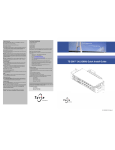
advertisement

Admin Menu
9.
10
11
12
13
14
1.
2.
3.
4.
5
6.
7
8.
Figure 12 EMS Admin
Menu
Use the commands on the Admin menu of the EMS GUI to perform administrative functions in the network. The following descriptions for each command lists the appropriate cross-references to specific topics in the documentation for detailed information.
1. Performance Templates: Define performance monitoring and capacity monitoring (VT/TU only) templates. See the Operations and
Maintenance Guide, Chapter 1—“Performance Monitoring.”
2. Bandwidth Profiles: Create Ethernet bandwidth profiles on the
TransNav management server.
3. Classifiers: Create Ethernet traffic management classifiers for
Traverse on the TransNav management server.
4. TE100 Classifiers (TE-100): Create Ethernet traffic management classifiers for the TE-100 on the TransNav management server.
5. Alarm Profiles: Set alarm profiles, including severities, for non-service-affecting and service-affecting alarms; also to disable and enable alarms. See the Operations and Maintenance Guide,
Chapter 2—“Managing Alarms.”
6. Customer: Define customer information. See
Chapter 8—“Generating and Viewing Reports.”
7. Gateway Processes: View the gateway processes in place to expand the scalability of the network. See the Software Installation Guide,
Chapter 6—“Creating the Gateway Application.”
8. IP Static Route Configuration: Add static routes to a node for management IP traffic.
9. DHCP Configuration: Configure a node to enable a user to manage the node with automatic IP configuration. For more information on setting up DHCP from the EMS server, see the TransNav
Management System GUI Guide, Chapter 3—“EMS Server
Administration Procedures,” Configuring DHCP.
10. OSI Static Route Configuration: Add static routes to a node for OSI
(open system interconnection).
11. OSI Parameters Configuration: Configure a node to be an OSI gateway node.
12. IP QOS Configuration: Set up a control list to allow or block traffic from certain IP hosts or networks. Outgoing messages can be prioritized as High Priority or Best Effort. See the TransNav
Management System Provisioning Guide, Chapter 5—“IP Quality of
Service.”
TransNav Management System GUI Guide, Release TN6.0.x
15
13. SNMP Configuration: Set the Traverse node SNMP agent read and write community strings, four trap destination IP addresses, ports, and trap community strings.
14. Attached Devices SNMP Parameters: Set the SNMP sub-shelf devices polling and synchronization intervals for the management server.
16 Chapter 1 General Description of GUI Features TN6.0.x
advertisement
* Your assessment is very important for improving the workof artificial intelligence, which forms the content of this project
Related manuals
advertisement
Table of contents
- 8 Map View
- 9 Shortcut Menus for Map View
- 11 Traverse Shelf View
- 13 Shortcut Menus for Shelf View
- 15 TE-100 Shelf View
- 16 Shortcut Menus for TE-100 Shelf View
- 18 Managing TE-206 Nodes from TransNav
- 19 EMS GUI Menus
- 19 File Menu
- 20 View Menu
- 21 Admin Menu
- 23 Security Menu
- 24 Tools Menu
- 25 Provisioning Menu
- 25 Help Menu
- 26 Node GUI Menus
- 29 GUI Conventions
- 29 Scroll Bars
- 29 Resizing Capabilities
- 32 Starting the GUI from the Management Server
- 34 Starting the GUI Application on a Windows Platform
- 36 Starting the GUI Application on a Solaris Platform
- 38 TransNav Client Workstation GUI User Login
- 40 Guidelines to Starting the Node-level GUI
- 40 Install the Node-level GUI
- 41 Starting the Node-level GUI Application on a Windows Platform
- 43 Node-level GUI User Login
- 46 Start the Server Administration Tool
- 46 Initialize the Database
- 49 Enable the Server as a Service (Windows)
- 49 Start the Server
- 51 Export (Backup) the Database
- 55 Stop the Server
- 56 Promoting a Secondary Server to the Primary Role
- 58 Disable Server as a Service (Windows)
- 59 Disable DEP Service on Server (Windows)
- 62 Upgrade Server Software
- 63 Download the Management Software from the Force10 Website
- 66 Import the Database
- 68 Configuring RADIUS Network Authentication
- 71 Retrieve Server Log Files
- 72 Setting Up Report Parameters
- 75 Customizing Background Images for Map View
- 77 Configuring DHCP
- 78 Setting a Broadcast Message
- 80 Terminating User Sessions in Bulk
- 81 Setting Administrative Options
- 88 Restore Default Server Parameters
- 89 Definitions
- 90 Password Changes
- 91 Guidelines to Managing Server Security
- 92 Domain User Access Roles
- 93 Domain Users
- 94 Functional Groups
- 97 Session List
- 99 Definitions
- 100 Node User Access Roles
- 101 Node Users
- 103 Prerequisites
- 104 Access Roles on TN-Sight
- 104 Provisioning TE-206 Nodes from TransNav
- 105 TE-206 Alarms and Events
- 105 TE-206 Node Database Backup and Restore
- 105 Removing TE-206 Nodes
- 108 Managing TE-206 Nodes from TransNav
- 109 Discovering TE-206 Nodes from TransNav
- 111 Password Criteria
- 111 Determining TE-206 Node User Privileges
- 113 Synchronizing TE-206 Node Users
- 116 Select Background Image for Map View
- 117 Saving and Importing User Preferences
- 118 Customize System Options
- 120 Grouping Nodes
- 127 Changing Node Group Names
- 129 Generating Reports
- 133 Generating a PM Report
- 134 Using the Report Scheduler
- 137 Adding Customer Information
- 138 Viewing Reports
- 140 Example Report Output
- 141 Removing Generated Reports
- 147 shelf view
- 147 service group tab
